This post includes two reports from Syria who provide essential insights about Western supported militias fighting to overthrow the Syrian government.
Dr. Franklin Lamb Intifada Palestine
Historical background
Every school kid in Syria learns at an early age about the various colonial land grabs that have lopped off key parts of their ancient country and they receive instruction about their personal national duty to recover this sacred territory.
One such land grab that is galvanizing resistance on behalf of Syria and against the Turkish, Qatar, and Saudi sponsored jihadists is the case of Iskenderun, north of Latakia. This area, which for thousands of years was part of Syria and is rich in natural resources, was cut from Syria and grafted onto Turkey by the French more than half a century ago.
Iskenderun preserves the name, but probably not the exact site according to historians, of Alexandria ad Issum where around 333 BC Alexander the Great camped and establishing the city. One importance of the place comes from its geographical location — it is the easiest approach to the open ground of Hatay Province and Aleppo.
It all started on July 5, 1938, when Turkish forces under Colonel Sukril Kanath with French approval launched an aggression and ethnically cleansed the local Armenian Christian and Allawi populations. The Turkish invasion was made possible by the French, partners with Britain in Sykes-Picot, who had remained as illegal occupiers of Syria as holdovers from the League of Nations mandate. The French successively were complicit in a rigged referendum and essentially ceded this Syrian territory of Iskenderun, by then referred to as the Republic of Hatay. The land grab was part of a secret deal to secure Turkey’s help in the approaching war with Germany. Paris and Ankara struck a deal that resulted in Turkey, while not joining the allies against Germany, declaring neutrality and essentially sitting out WW II.
Rather than trying to expand, as it sometimes is accused by Turkey and Israel, Syria has been constantly losing territory. It lost northern Palestine in 1918, Lebanon in 1920, and the Iskenderun area through French duplicity in 1938. In 1967 it lost Golan. Syrian patriots intend to recover all this territory starting with Iskenderun.
One retired Western diplomat, speaking only for himself and representing no government, told me on this subject: “Surely Lebanon must also be returned to Syria. It was never a real country and it never will be as far as I am concerned. It is part of Syria!” After World War I, most Lebanese wished their land to remain part of Syria (see the results of the King-Crane commission) rather than live in a separate nation under French domination. As we parted, the former diplomat shook my hand and declared: “Of course Iskenderun is also part of Syria. No honest person can deny this!”
Founding the PLFI
Ali Kayali (aka Abu Zaki) hails from Turkish occupied Syria (Iskenderun) and leads one of the most effective pro-government militias in the northern part of Syria while vowing to one day liberate and restore Iskenderun to Syria. In 1982 He went to Beirut to resist the Israeli aggression. Soon he was, in one sense, being baptized under fire, while carrying the banner of his new group, The Popular Front for the Liberation of Iskenderun (PFLI) under the tutelage of Dr. George Habash’s Popular Front for the Liberation of Palestine (PFLP). He fought on a number of south Lebanon fronts and inside West Beirut.
After studying on his own in Tartus, and having escaped from prison in Turkey, where he was being jailed for demonstrating against the regime, he returned to Tripol, Lebanon and joined Syrian army battles against the Bilal Shaaban led Al Tawhid al-Islami (Muslim Brotherhood) and from then he and the PFLI moved to the area of Halba in Akkar, Lebanon, organizing a resistance training camp. Eventually he returned to Syria where his group was supported by Syrian citizens but was not formally part of the Syrian security/resistance apparatus.
Speaking with non-government analysts in Latakia, I was repeatedly told that the PFLI has the reputation of understanding the geography and politics of the Syrian coast area where its fighters are currently active (including Aleppo, Banias, Tartus, the countryside around Latakia, as well as the Idlib, Homs, and Damascus areas).
Talking to PFLI fighters and officials, I was briefed on the past two years of PFLI Resistance in Syria. One of the places where the PFLI is currently fighting is in the strategic rebel bastion of Yabrud in the Qalamoun Mountains, north of Damascus near the Lebanese border. On March 3, during a meeting with me and some of his associates, Ali Kayali got a phone call with information that Sahel village, about four miles from Yabrud, is now controlled by Syrian forces including the PFLI. Ali, who is open and forthcoming with battlefield details, explained that pro-Syria forces do not want to storm Yabrud but rather to control the villages surrounding it in order to corner al-Nusra and other rebel militias inside.
When asked about the trapped local population and whether their likely fate is not the same as the inner city populations of Aleppo, Homs, and a dozen other locations, Ali shrugged and turned up his palms.
Today, (March 7) the PFLI is fighting to cut off the road linking Yabrud to Arsal in eastern Lebanon, whose majority population supports the Syrian revolt. They were involved last week with the fall of Al-Sahl, a town a little over a mile south of Yabrud, and are now fighting in and around Yabrud preparing for the anticipated final assault. According to Ali’s personal body guards, they are facing Al-Qaida’s Syrian affiliate, Jabhat al-Nusra. Some of PFLI’s 3000 troops are also fighting this week in Douma, Jobar, Aleppo, the countryside around Lattakia, and Deralcia near Nubek on the main Damascus-Homs highway.
According to Ali Kayali the PFLI receives sporadic support from the local community. The PFLI needs money, weapons, and regular supplies of food. The PFLI also needs places for the fighters to sleep at the various battle sites, more uniforms because of an increasing influx of new members, and funding for death benefit payments to the families of killed PFLI men and women.
PFLI fighters get no salaries, which sets them far apart financially from most Gulf backed (and often Western trained) militias who can garner monthly salary payments of between 500 and 1,000 US$. By contrast, pro-government popular committees numbering approximately 5,000 and National Defense units which number approximately 25,000 fighters, receive approximately 20,000 Syrian Pounds or 126 US$ each month. Footing much of this bill are Syrian businessmen like Rami Mahlouf, cousin of President Bashar al-Assad. Regular Syrian army recruits get only 3000 Syrian Pound or about $20 monthly but they also receive food and lodging, plus health and travel benefits. Syrian army reservists are said to receive approximately 10.50 US$ per month.
For Ali Kayali, the PFLI which he commands is also a family matter. His wife and daughter and two sons are deeply connected with the Resistance goals of the PFLI. The sons are fighters and his wife and daughter are fighters when called upon and otherwise they are involved in related resistance projects. His 22 year old daughter, nicked-named “Joan of Arc” is in medical school but is also reputedly a ferocious fighter and battlefield tactician, with dramatic results in a number of attacks against rebels over the past nearly two years. She is a strong no-nonsense feminist and told me she loves to shock takiris who sometimes appear amazed to see her and her female unit chasing them up the side of some mountain.
Captagon Jihad
Sitting in the lobby of a run-down, less than one star dock-side hotel, opposite the Mediterranean and used for sleeping by various militia, I spoke leisurely one early morning with a son of Ali Kyali who is, when not fighting jihadists, among his father’s bodyguards. I have for a while been interested in Western government claims that it was supplying “humanitarian non-lethal aid” to rebel groups including night goggles, telecommunication equipment, and GPS devices. I view all this equipment as misnamed and think it indeed constitutes lethal aid as the equipment helps one side killing the other via night snipers and is facilitating troop movements.
I was a bit surprised to learn what PFLI fighters thought of this kind of equipment being given to their adversaries. Ali’s son told me: “Not having night goggles, except for some we take off the enemy is not much of a problem for us because we can sense where al-Nusra fighters are, and they tend not to fight at night.” I asked why they didn’t fight in the night, thinking maybe it had something to do with a religious edict of some sort. But I was mistaken. Ali’s son explained, “No it is not that, it’s because they are too paranoid and exhausted from taking Captagon and even stronger drugs”. According the guys I was sitting with, some with more than two years fighting experience in the PFLI, many if not most of the Gulf sponsored jihadists are given bags of pills to enhance their battle field courage. And it works to a degree.
At dawn each day, jihadists take drugs, including sometimes large doses of Captagon and other available drugs including but not limited to potent substances locally known as “Baltcon”, “Afoun”,”Zolm”. They also use Opium, Heroin, Cocaine, and Hashish. The main drug supplies for the Syrian battle zones come from Pakistan, Afghanistan, Lebanon, lesser amounts come from Turkey, Iraq, and Jordan. Lebanon’s Bekaa valley produces large quantities of Captagon pills for shipment to the Gulf and now to Syria.
Jihadists high on drugs apparently feel invincible and do not fear death. Many are indeed ferocious and fearless fighters during the day, as many media sources have reported. But by nightfall, when the drugs wears off the fighters become exhausted and sometimes they are found asleep on the spot where they were fighting. Ali’s son explained that “many of the “Gulfies” are in fact heavily addicted to strong heroin like drugs and they crave them and sometimes they even fight with their fellow militiamen to get their fixes. “We were told by some we captured that when one of them is killed his comrades will descend on his body, not particularly to pray over it but to rummage his pockets for drugs.”
In 2011 alone, Lebanese authorities confiscated three amphetamine production labs and two Captagon-producing labs which they claim sent hundreds of thousands of pills to the Gulf states, which forward the stimulants to their fighters in Syria. The seizure of trucks with Captagon in their chassis in Lebanon and at Beirut airport shows a growing demand for these products among Syrian militias.
As some media outlets have reported, Jabhat aL-Nusra and ISIS (the most extreme “imported jihadists” as some here call them) claim to be better fighters than Hezbollah, whose units set the fighting-skill bar fairly high these days. Some also claim that they have not really started their battle to defeat Hezbollah on its own territory but will do so when they are ready and that they have no doubt they will defeat Hezbollah. But as one PFLI fighter explained, with some of his buddies nodding agreement, only when high on drugs do Qatari/Saudi jihadist’s exhibit bravery and bravado, posing a serious threat because they ignore normal defensive fighting tactics. “We know many of these guys quite well and lots of them were never even religious. There are many who are drug addicts and when they get high they lose their fear of dying. So they are dangerous to confront and they often use strange tactics.”
According to another PFLI source, the “imported jihadists” die in high numbers because they ignore the battle field realities. Their average number of death in any given firefight over the past two years is estimated to be approximately five times the number of Hezbollah casualties.
How the Maaloula nuns were freed
Mohammad Ballout As-Safir
Shortly before midnight March 9, the suffering of the 13 Maaloula nuns and their three aides ended with them being freed. Another kidnapping file in Syria has been closed. It was a case similar to that of the kidnapped Lebanese in Azaz in terms of battlefield pressure (which tightened the noose around the kidnappers), the role played by Lebanon and other regional mediators, and the details of the exchange deal. The next question is if the case of the kidnapped bishops Youhanna Ibrahim and Boulos Yazigi can be solved similarly (and if they are alive still).
The last few meters of the nuns’ trip to freedom were not easy. There were a lot of breaths held, there were ups and downs in expectations before the matter ended in the early hours of the morning as the nuns reached Jdeidet Yabous, where they were received by the mediator who played a key role in their release, the director of the Lebanese General Security Directorate, Maj. Gen. Abbas Ibrahim. Also present was a delegation representing the Orthodox patriarchate, the Syrian minister of endowments, the bishop of Damascus, the governor of Damascus, and others who had followed the nuns’ case from A to Z.
The nuns’ release was the culmination of long and thorny negotiations, which lasted for three months involving various states, especially Qatar, and were mediated by Maj. Gen. Ibrahim under the auspices of Lebanese President Michel Suleiman.
The freed nuns’ reached Jdeidet Yabous from a point inside Syria, accompanied by a convoy from the General Security Directorate, one of whose patrols had received the 16 nuns and aides at Wadi Ata in the barren environs of Arsal. The release operation had hit a snag due to last-minute pressure by the kidnappers to amend the terms, which almost threatened to scuttle the deal. But the kidnappers then agreed to the original terms after Maj. Gen. Ibrahim categorically refused any attempt to amend the provisions of the deal.
It has been learned that in the last minutes before the exchange, the kidnappers proposed increasing the number of female detainees they were demanding be released (whereby eight nuns would be released first and the rest later) and that the Syrian government had to release dozens of female detainees in multiple stages as well. Ibrahim refused that proposal. He told the kidnappers that the deal would be either implemented as agreed upon and all the nuns would be released together, or the entire operation would be canceled.
What provided impetus to the negotiations was that the Syrian army demanded that the nuns be released within 24 hours in conjunction with the battlefield situation around Yabrud, where the nuns were being held. That prompted the gunmen to agree on the deal as is.
Freeing the Maaloula nuns emerged as part of a deal involving the release of female detainees in Syrian prisons (more than 100 according to Ibrahim) and giving the kidnappers 16 million US$, which Qatar agreed to pay. Qatar’s intelligence chief Ghanem al-Qubaisi arrived in Lebanon on March 8.
Details of the exchange deal
Intermittent and complex negotiations took place since the abduction of the Maaloula nuns on December 3, 2013. Three different channels negotiated with the deputy emir of Jabhat al-Nusra in Qalamoun, Abu Azzam al-Kuwaiti, at his headquarters in Yabrud, before a mutual understanding was reached.
In the wake of the kidnapping, two negotiating tracks were launched on the basis of the nuns being “guests” who could easily be freed, because they were not hostages. This scenario was repeated by Syrian opposition figures such as Michel Kilo to provide political cover for the kidnapping. After the abduction, Kilo had said that the Maaloula nuns were the guests of a friend in Yabrud and had not been kidnapped.
In the first few weeks, before Qatar joined the negotiations, Abu Azzam al-Kuwaiti had taken the nuns from Mithqal Hamama, their original kidnapper and a smuggler between Lebanon and Syria. Hamama is one of the leaders of the Sarkha Brigades, the group that kidnapped the nuns during the second attack on Maaloula in December.
At first, the kidnappers approached the United Nations’ office in Damascus and its head representative, Mokhtar Lamani, but Lamani refused to go to Yabrud and negotiate directly with Jabhat al-Nusra after talking with al-Kuwaiti via Skype. The UN headquarter in New York had instructed Lamani to reject any direct contact with Jabhat al-Nusra, which is on the terrorists list. So, the negotiations stopped.
A second track had opened in parallel with the faltering UN track. A businessman from Yabrud, George Hasswani, played a prominent role in the negotiations. He was not a mediator in the strict sense of the word. Hasswani is close to the Syrian government and he passed on and responded to the back-and-forth offers of exchange in coordination with Maj. Gen. Ibrahim. Hasswani sometimes restored the negotiating path with the kidnappers to its proper scope to gain time by responding to his one and only negotiator, al-Kuwaiti (who btw. never took off his explosives belt while talking with Hasswani via Skype).
During the negotiations, the kidnappers and the hostages moved to Hasswani’s residence in Yabrud, which Jabhat al-Nusra had taken over in his absence. Hasswani paid the costs for the kidnappers living in his three-story residence to improve the conditions under which the nuns were being held and to make talking to them easier.
The kidnappers repeated that they were not looking for a ransom and that all they wanted was to exchange the nuns for female detainees in Syrian government prisons. At first, the kidnappers presented a list with hundreds of names, before settling on 138. They insisted that the negotiations would only continue if the Syrian government made a goodwill gesture and released an Iraqi prisoner named Saja Hamid al-Dulaimi, the wife of an Iraqi al-Qaeda official. Syrian authorities had detained Saja along with three of her children in an operation outside Damascus.
The Syrian government rejected the request because Dulaimi was not a Syrian detainee and said that not all the names submitted by Kuwaiti were being held by the government. The Syrian government said that it had no information on 66 of the 138 names, released 10, and said that 23 others could be released.
Those following the negotiations became convinced that by requesting Dulaimi’s release, al-Kuwaiti was only a front for the true negotiators, who were somewhere else. During the negotiations, al-Kuwaiti was never able to respond to the offers made to him. It later became apparent that he was no more than an intermediary, controlled by other parties in Jabhat al-Nusra, which is led by Abu Mohammed Golani, Nusra’s emir in the Levant.
The negotiations on the Syrian track stalled earlier this year, and the Qatari track was activated in coordination with Maj. Gen. Ibrahim during the last month. Qatari envoys visited the area around the mountains in Arsal and began to speak directly with the kidnappers but without making the slightest progress. The kidnappers gave Ibrahim a list with the names of no less than 1,000 Syrian female detainees. The Syrian authorities refused to negotiate and considered the list non-serious.
It was noteworthy that the list contained some 150 names of Islamist detainees in Lebanon’s Roumieh prison, most of whom were not Lebanese nationals. Maj. Gen. Ibrahim’s position, in coordination with President Suleiman and former Prime Minister Najib Mikati, was to categorically refuse to negotiate the release of any prisoners in Roumieh.
The battlefield reality revived the negotiations
A Syrian official who followed the negotiations said that the negotiations were revived a few days ago after important developments in Yabrud that were similar to the circumstances surrounding the deal in Azaz.
During the past two weeks, the Qalamoun battle had been raging, involving 10,000 fighters on all fronts. The original kidnapper, Mithqal Hamama, was killed, which freed the hands of the other negotiators.
A week ago, the kidnappers decided to leave Hasswani’s residence in Yabrud as the Syrian army approached and the strategic hills around the Rima Farms, on the outskirts of Yabrud, fell into the hands of Hezbollah and the Republican Guard. The nuns were separated and taken to a number of sites in Yabrud.
Two days earlier, Abu Yazin, the head of the al-Ghuraba brigade in Qalamoun, had reopened contacts with the Syrian government via the Qatari mediator. Abu Yazin called for quickly making a deal. He requested 16 million US$ and the release of the female detainees on a list.
Abu Yazin also wanted to make security and military matters part of the deal. He requested a ceasefire around Yabrud and a cessation of the bombings. He also requested corridors for the withdrawal of 1,500 gunmen from Yabrud to Rankous and Arsal, but that condition was flatly rejected.
Qatar agreed to pay the ransom and the Syrian authorities agreed to release the detainees. But introducing security and military matters into the exchange deal was entirely ruled out.
Maj. Gen. Ibrahim thanked the Syrian leadership, which provided all the facilities necessary to complete the exchange deal. He said that he would follow up on his promise to try to obtain the release of the kidnapped bishops. Ibrahim stressed, “The Maaloula nuns are fine and in good health. … We have abided by our commitments but the kidnappers tried to deviate from the agreement in the final hours. But we refused any bargains.”
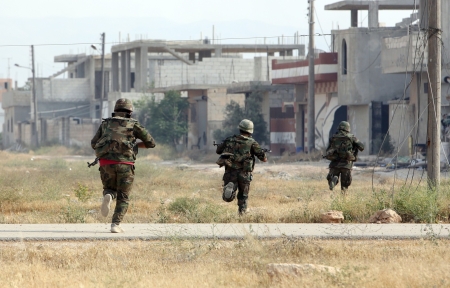
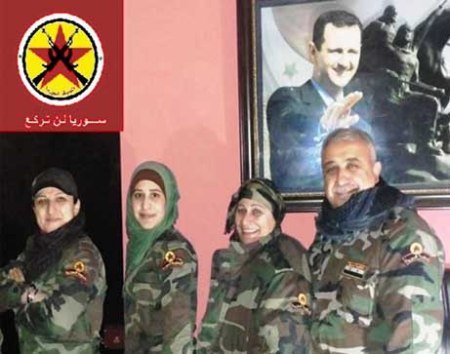
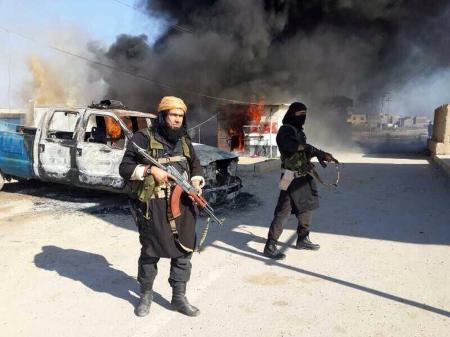
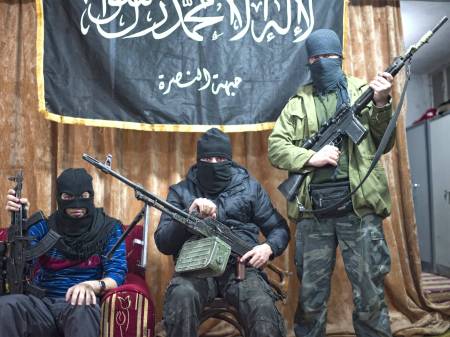

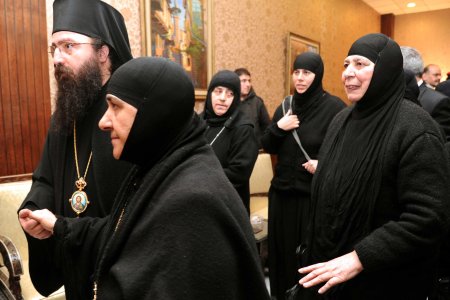
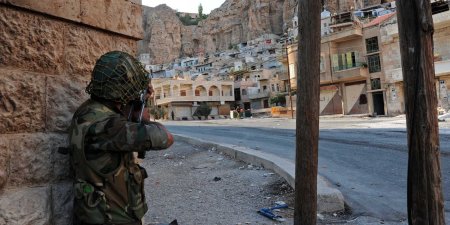
Keine Kommentare:
Kommentar veröffentlichen